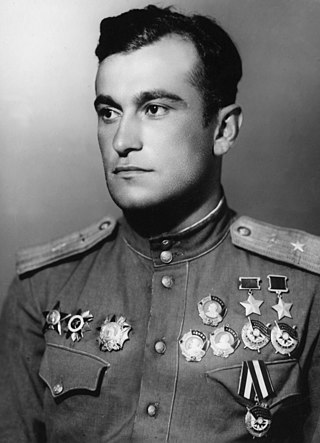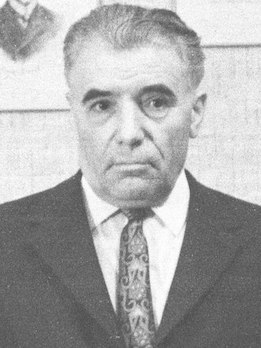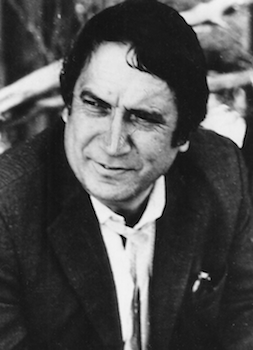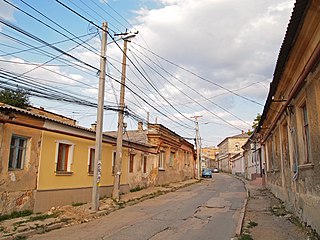Related Research Articles

Amet-khan Sultan was a highly decorated Crimean Tatar flying ace in the Soviet Air Force with 30 personal and 19 shared kills who was twice awarded the title Hero of the Soviet Union. Despite having been able to avoid deportation to Uzbekistan when the entire Crimean Tatar nation was repressed in 1944 due to his father's Lak background, he refused to change his passport nationality listing to Lak or identify as one throughout his entire life despite pressure from government organs. After the end of the war, he worked as a test pilot at the Flight Research Institute in Zhukovsky and mastered piloting 96 different aircraft types before he was killed in a crash while testing a new engine on a modified Tupolev Tu-16 bomber. He remains memorialized throughout Ukraine and Russia, with streets, schools, and airports named after him as well as a museum dedicated to his memory.

Sharof Rashidovich Rashidov was the First Secretary of the Central Committee of the Communist Party of Uzbekistan from 1959 until his death in 1983. During his tenure the Uzbek SSR saw considerable economic growth and had a very high degree of autonomy from the rest of the Soviet Union.

Mustafa Abduldzhemil Jemilev, also known widely with his adopted descriptive surname Qırımoğlu "Son of Crimea", is the former Chairman of the Mejlis of the Crimean Tatar People and a member of the Ukrainian Parliament since 1998. Commissioner of the President of Ukraine for the Affairs of the Crimean Tatar People (2014–2019). He is a member of the Crimean Tatar National Movement and a former Soviet dissident.

After it was established on most of the territory of the Russian Empire, the Soviet Union remained the world's largest country until it collapsed in 1991. It covered a large part of Eastern Europe while also spanning the entirety of the Caucasus, Central Asia, and Northern Asia. During this time, Islam was the country's second-largest religion; 90% of Muslims in the Soviet Union were adherents of Sunni Islam, with only around 10% adhering to Shia Islam. Excluding the Azerbaijan SSR, which had a Shia-majority population, all of the Muslim-majority Union Republics had Sunni-majority populations. In total, six Union Republics had Muslim-majority populations: the Azerbaijan SSR, the Kazakh SSR, the Kyrgyz SSR, the Tajik SSR, the Turkmen SSR, and the Uzbek SSR. There was also a large Muslim population across Volga–Ural and in the northern Caucasian regions of the Russian SFSR. Across Siberia, Muslims accounted for a significant proportion of the population, predominantly through the presence of Tatars. Many autonomous republics like the Karakalpak ASSR, the Chechen-Ingush ASSR, the Bashkir ASSR and others also had Muslim majorities.
The Crimean Socialist Soviet Republic or the Soviet Socialist Republic of the Crimea was a state allied with Soviet Russia that existed in Crimea for several months in 1919 during the Russian Civil War. It was the second Bolshevik government in Crimea and its capital was Simferopol.

Uzeir Abduramanovich Abduramanov was a sapper in the Red Army during the Great Patriotic War. After securing the safe transfer of troops across the Sozh river under heavy enemy fire and through icy water, he was awarded the title Hero of the Soviet Union on 15 January 1944.

Teyfuq Amitovich Abdul was a Crimean Tatar Hero of the Soviet Union who served as the commander of the 2nd battalion of the 175th Guards Rifle Regiment during the Second World War.

Yuri Bekirovich Osmanov was a scientist, engineer, Marxist–Leninist, and Crimean Tatar civil rights activist. He was one of the co-founders of the National Movement of Crimean Tatars, which sought full right of return of the Crimean Tatar people to their homeland and restoration of the Crimean ASSR.

Şamil Alâdin was a Crimean Tatar writer, poet, translator, and civil rights activist. Early in his career he wrote poetry, later moving on to prose and nonfiction works.

Seit Memetovich Tairov was the highest-ranking Crimean Tatar politician in Soviet Union after the Sürgün, having risen to prominence as a leader in Akkurgan and then first secretary of the Jizzakh regional committee of the Communist Party. A controversial figure among Crimean Tatars today, he is remembered for his staunch opposition to full right of return to Crimea. As a public supporter of "taking root" in Uzbekistan, he was one of the top signatories of the notorious "Letter of Seventeen" in March 1968 that downplayed Crimean Tatar struggles and discrimination in exile and urged Crimean Tatars to avoid "succumbing" to desires to return to Crimea.

Rollan Kemalevich Kadyev was a Crimean Tatar physicist and civil rights activist in the Soviet Union. A defendant in the Tashkent process, he became known as a firebrand opponent of marginalization and delimination Crimean Tatars, publicly denouncing the restrictions on returning to Crimea as well as the government policy of claiming Crimean Tatars were not a distinct ethnic group that was exemplified by official use of the euphemism "people of Tatar nationality who formerly lived in the Crimea" instead of their proper ethnonym of "Crimean Tatar". For his activities such as distributing leaflets and verbally confronting those who endorsed the status quo against of national policy relating the Crimean Tatars, he was imprisoned on charges of "defaming the Soviet system", despite passionately making the case that discriminatory and assimilationist policies against Crimean Tatars was a huge deviation from proper Leninist national policy. Later on in his life he significantly softened his tone after a 1979 imprisonment for getting into a fight with a party organizer, controversially signing off an open letter critical of Ayshe Seitmuratova's activities with Radio Liberty, which was published in Lenin Bayrağı and Pravda Vostoka in February 1981.

Mustafa Veisovich Selimov was a Crimean Tatar communist leader, partisan, and civil rights activist. Having been the First Secretary of the Yalta Communist Party before the war, he served as the commissar of a partisan formation during the war before being exiled the Uzbek SSR as a Crimean Tatar, where he went on to hold leadership positions in the Ministry of Agriculture of the Uzbek SSR and become one of the original organizers of the Crimean Tatar civil rights movement, for which he received reprimand from party organs.

Abdulcelâl Hayrulla Meñbariyev was a politician who served as the chairman of the Presidium of the Supreme Soviet of the Crimean ASSR from 1937 to 1944.

Dzhebbar Akimov was a Crimean Tatar teacher, writer who worked as editor of the newspaper "Qızıl Qırım" until the Sürgün. In exile, stood at the origins of the Crimean Tatar rights movement, becoming the leader of the Bekabad initiative group as well as authoring many documents about their plight for which he was expelled from the party in 1966, dubbed "the most active supporter of returning to Crimea" by the government in 1967, and eventually sentenced to three years in prison in 1972. Like many other leaders of the original Crimean Tatar rights movement, he considered himself a communist and opposed the prospect of members of movement associating with Soviet dissidents like Andrey Sakharov and Pyotr Grigorenko.

Cafer Seydamet, also known by his adopted surname Qırımer, was a Crimean Tatar politician and writer who was one of the founders and leaders of Milliy Firqa and Crimean People's Republic. He served as Prime Minister and Director of Foreign and Military Affairs in the Crimean People's Republic, and maintained the latter role within the Crimean Regional Government.

Veli İbraimov, also written as Veli Ibrahimov, was a Crimean Tatar revolutionary and Soviet politician who served as the second Chairman of the Central Executive Committee of the Crimean Autonomous Soviet Socialist Republic, serving from 1924 to 1928. Originally a member of Milliy Firqa and a delegate to the first Qurultay of the Crimean Tatar People, İbraimov joined the Russian Communist Party in 1918 and became a national communist authority within Crimea. An opponent of Jewish autonomy in Crimea, he met his downfall for his acts which were accused of being exclusively in the interests of the Crimean Tatars, and he was removed from his post and executed in 1928. In 1990, he was rehabilitated by Soviet authorities due to lack of evidence.

Old Simferopol, known locally as the Old Town, is an area of the city of Simferopol which until the end of the 18th century served as the centre of the city of Aqmescit. The old town consists of narrow, short streets constructed in a traditional Turkic style. In the 19th century it was also referred to by travellers as the "Asian town" because of the contrast with Simferopol's other regular, European-style neighbourhoods. Today, some of the neighbouring 19th-century, single-storey, European-style buildings are also considered to be part of the old town. The area is bounded by Lenin, Sevastopol's'ka, Krylov, and Chervonoarmiis'ka streets. The population of the old town is approximately 50,000.
Mustafa Seydulayevich Chachi was the director of the 5th division of the "Five-Year Plan of the Uzbek SSR" sovkhoz in Oqqoʻrgʻon District of Tashkent region, Uzbek SSR, and an innovator of organizing productive labor and implementing new methods. He was awarded the title of Hero of Socialist Labor in 1966 and was one of the signatories of the notorious letter of seventeen telling other Crimean Tatars to give up dreams of returning to Crimea.
Emir Lümanovich Lümanov was an officer in the Red Army during World War II. After he was killed in battle against numerically superior German forces he was nominated for the title Hero of the Soviet Union, making him the first Crimean Tatar nominated for the title, but he was only awarded the Order of Lenin.
Abselâm Islâmov was a Crimean Tatar party worker, commissar, and journalist. For 25 years, he was the chief editor of the Crimean Tatar language newspaper Lenin Bayrağı.
References
- ↑ "Kırım'da efsanevi "Yañı Dünya" (Yeni Dünya) ve "Yıldız" yayınları tehdit altında". Kırım Haber Ajansı. 2 December 2015. Archived from the original on 31 March 2019. Retrieved 31 March 2019.
- 1 2 "Газета «Янъы дюнья»". mediacentr.org.ru (in Russian). Retrieved 2021-05-10.
- ↑ Materialy samizdata: Samizdat materials (in Russian). Ohio State University, Center for Slavic and East European Studies. 1984.
- ↑ "Kırım'ın efsanevi "Yañı Dünya" gazetesi Baş Editörü istifa etti". Kırım Haber Ajansı. 29 August 2018. Archived from the original on 31 March 2019. Retrieved 31 March 2019.
- ↑ "Газета «Янъы дюнья»". ГАУ РК "Медиацентр им. И.Гаспринского" (in Russian).